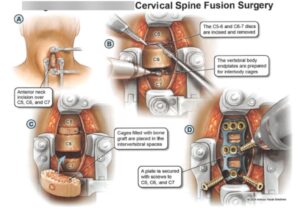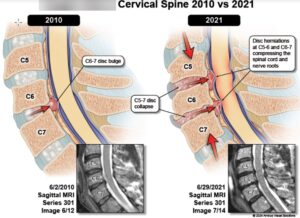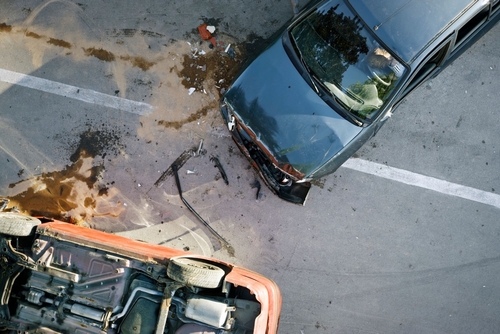RESULTS: $930,000 Personal Injury Settlement
DATE: 2024
ATTORNEY: Richard N. Shapiro
STAFF: Paula S., Paralegal
WHAT HAPPENED:
In February 2021, a federal worker employed with the Department of Homeland Security, age 67, was operating his car down Battlefield Parkway in Leesburg, Virginia, when a driver of a Ford Expedition failed to yield at an intersection and attempted a left turn instead of properly yielding the right of way. The massive crash was caught on highway traffic cameras, which plainly showed our DOT employee client had the right of way. Massive damage resulted to both vehicles.

Our client was extracted from his Kia with the help of fire and rescue workers and transported to the hospital with a comminuted tibial plateau fracture of his right leg, fractures to fingers of his left and right hands, a sternum fracture, foot injury, as well as head and neck injuries. He was hospitalized and stabilized for several days and then released to a rehabilitation facility with splints on his hands and leg, and he was wheelchair-bound. Occupational and physical therapy helped him with his legs and his arms. However, by the date of his discharge from the facility, he was still in a wheelchair and receiving home health physical therapy for several weeks.
 Later, in 2021, his orthopedic surgeon conducted a two-level fusion and laminectomy of his neck, and, notably, he had suffered intermittent neck problems for at least three decades of his life before this crash occurred. The insurance carrier representing the at-fault driver refused any substantial settlement, arguing that the neck surgery was completely unrelated to the car collision and was required due to his pre-existing injuries that had stretched on for decades.
Later, in 2021, his orthopedic surgeon conducted a two-level fusion and laminectomy of his neck, and, notably, he had suffered intermittent neck problems for at least three decades of his life before this crash occurred. The insurance carrier representing the at-fault driver refused any substantial settlement, arguing that the neck surgery was completely unrelated to the car collision and was required due to his pre-existing injuries that had stretched on for decades.
LEGAL STRATEGIES:
When our firm was retained, and the insurance company was low-balling us, the key issue was whether the orthopedic surgeon who did the surgery on our client believed that the collision had precipitated the need for neck surgery, especially in light of our client’s longstanding neck problems, including his pre-crash treatment by the orthopedic practice which conducted the surgery.
We reviewed all medical records, including those at the orthopedic surgery practice, going back over a decade, and what we learned is that our client had not been treated for 5 1/2 years prior to the accident, meaning his last appointment was in 2015. A careful review of the records showed that our client definitely had pre-existing neck problems but that he was managing them well, working full-time for the Department of Homeland Security, and otherwise had no treatment for his neck for over five years before the collision. Counsel interviewed his orthopedic surgeon as to his opinions before any court deposition, and we learned that his doctor absolutely believed, based on before and after MRI studies of his neck, that the car crash had caused new protrusions of his neck discs and precipitated his new neck pain.
We wanted to be sure that we developed medical illustrations to show the nature of our client’s neck injury, to compare the prior MRI to the post-collision MRI, and to generally demonstrate the range of different traumatic injuries our client suffered beside his neck. Some of these custom-created medical illustrations are shown here.


We voluntarily attended mediation several months before the scheduled trial date in Loudoun County Circuit Court in April 2024. At mediation, the defendant and their insurance company finally put an offer of $750,000.00 forward on the case. The problem was that our client’s past medical expenses totaled $386,000.00, and, unfortunately, he didn’t have a great result from the neck surgery in October 2021. His surgeon had placed a number of notes in the file that he might need a revision surgery because the bone did not fuse well at one of the two levels of his neck fusion.
In personal injury cases, if a physician testifies that a patient will need surgery in the future, it is admissible if the doctor believes the surgery is required to a reasonable degree of medical certainty. That means that it’s more probable than not that the surgery will occur in the future. But that’s only half the battle. In order to get all of the medical expenses for a future surgery into evidence, additional steps are required.
Most surgeons are not familiar with even the cost of their surgery or the hospital costs for such a future surgery, so life care planners, who are well and highly qualified nurse professionals, create complete life care plans but also create something called a medical cost projection. A medical cost projection is a static plan. It only deals with one issue and its associated costs, and that’s how it varies from a life care plan, which often covers expenses and costs of a wide range of activities over many years.
We engaged a life care planner to create a medical cost projection, and it requires that the professional reach out to a surgeon and have them provide details of the anticipated surgery, which usually includes what are called CPT codes. Our consultant did this with the orthopedic surgeon and then researched the cost in the area where the surgery was anticipated to occur in northern Virginia. Not only was the orthopedic surgeon deposed and cross-examined about his opinions relating to a future surgery, but the life care planner who created the medical cost projection also gave a deposition and defended her plan and the costs in the plan.
Finally, in the weeks before the trial, the offers increased to a point where our client was satisfied, and the case was settled for $930,000.00 the week before trial. This case required our law firm to reach out to many professionals; the case involved depositions of an orthopedic surgeon on the neck issues, a separate orthopedic surgeon on the thumb pulley release surgery, the physician who wrote the discharge report from his original hospitalization, and a deposition of the medical director of the rehabilitation facility. We used a graphic artist for some exhibits for the trial and created custom medical illustrations well before the trial. Also, we had a videographer edit videotaped depositions for presentation at trial, even though the case settled the week before.
